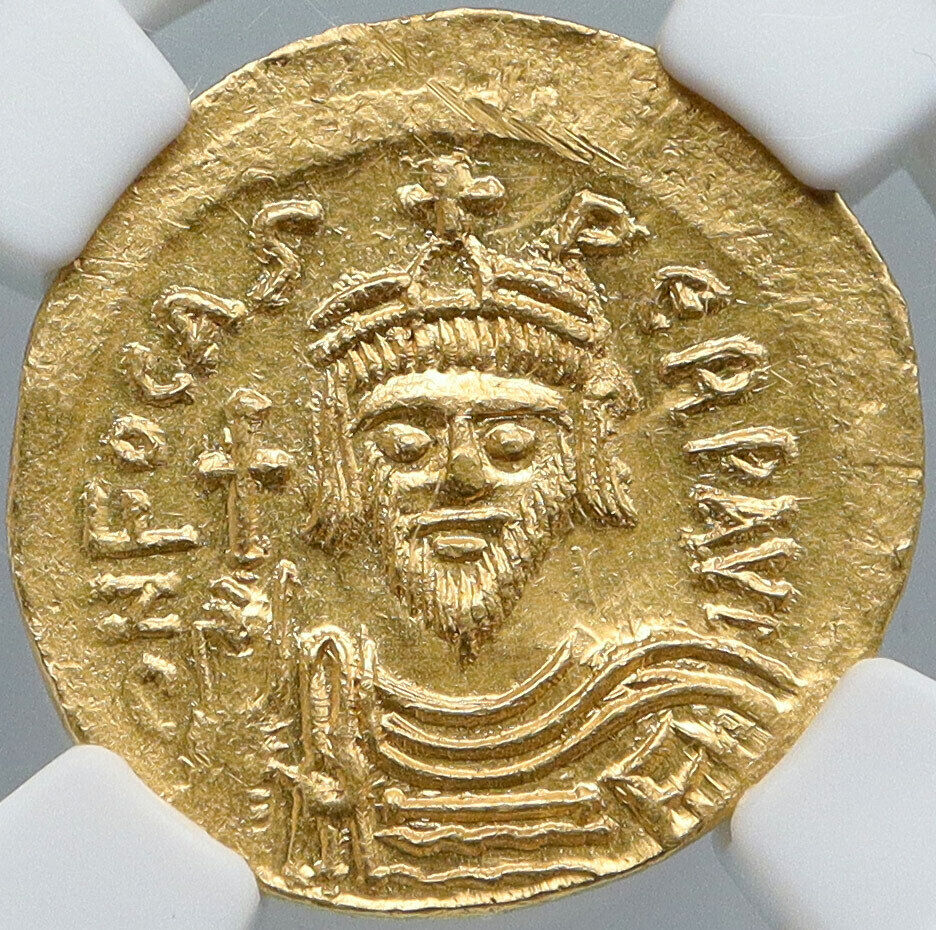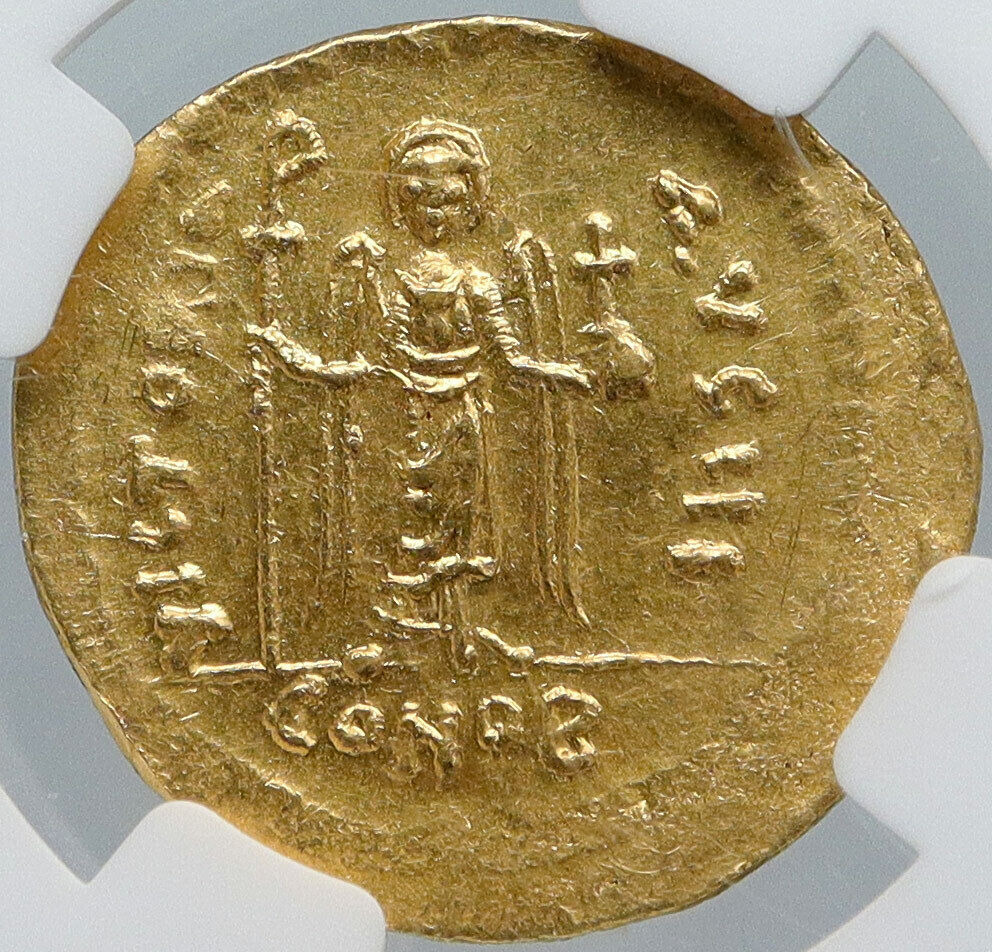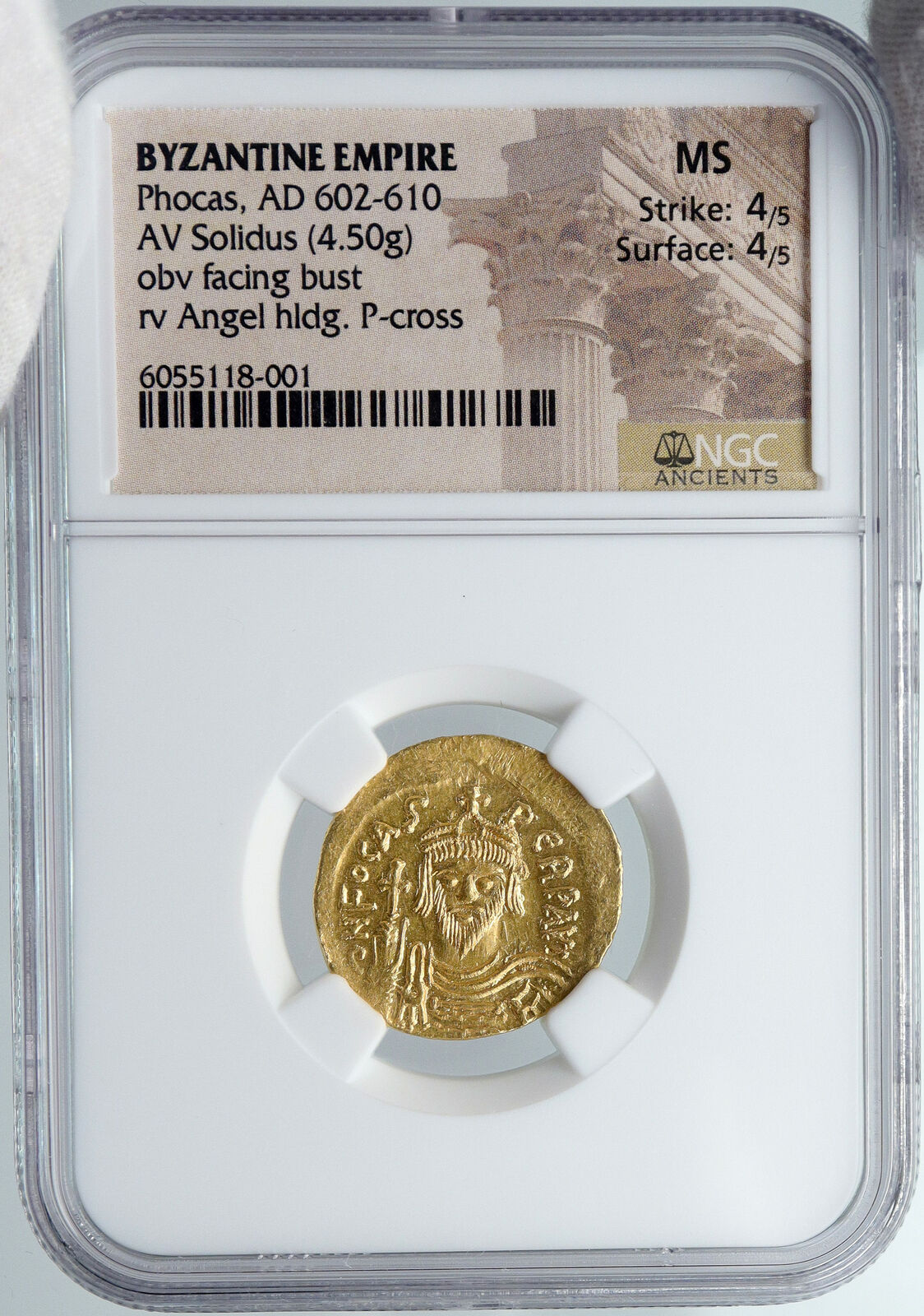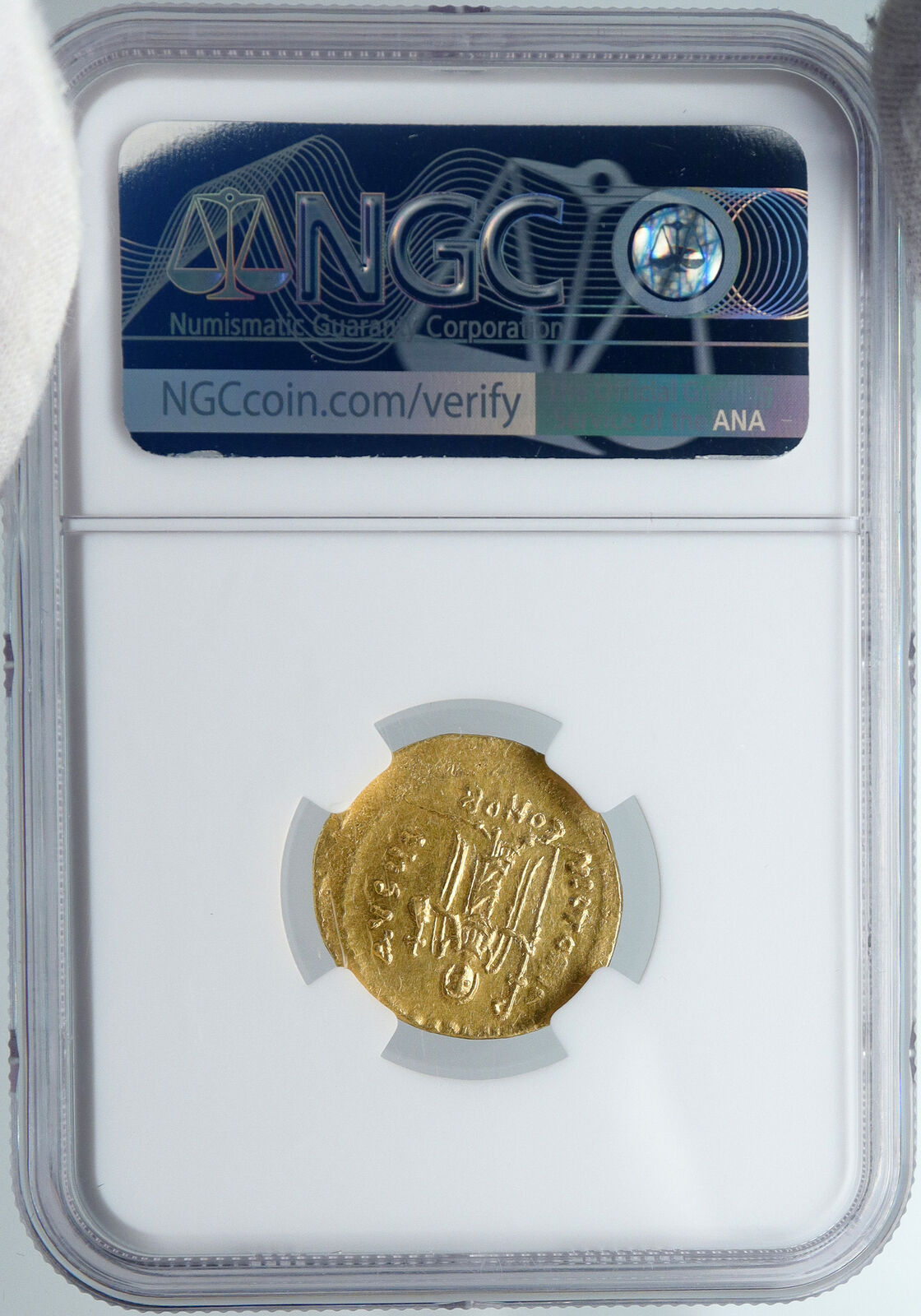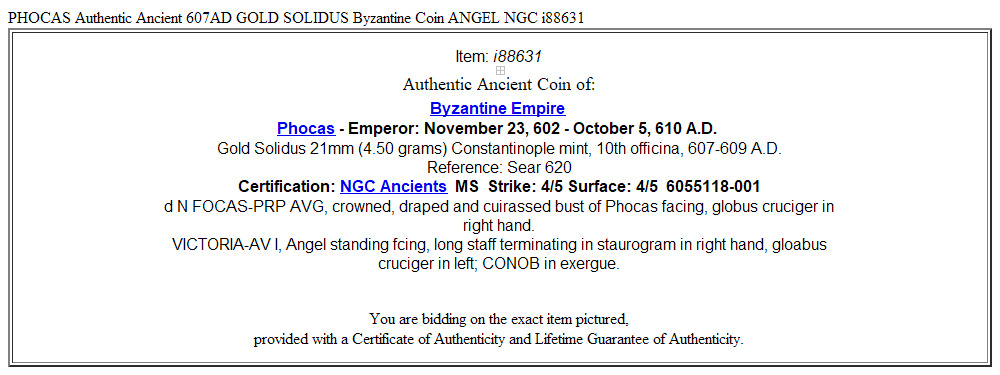PHOCAS Authentic Ancient 607AD GOLD SOLIDUS Byzantine Coin ANGEL NGC i88631
$2,111.36 (-40%)
Item:
i88631
Authentic Ancient Coin of:
Byzantine Empire
Phocas
– Emperor: November 23, 602 – October 5, 610 A.D.
Gold Solidus 21mm (4.50 grams) Constantinople mint, 10th officina, 607-609 A.D.
Reference: Sear 620
Certification:
NGC Ancients
MS Strike: 4/5 Surface: 4/5 6055118-001
d N FOCAS-PЄRP AVG, crowned, draped and cuirassed bust of Phocas facing, globus cruciger in right hand.
VICTORIA-AVϚЧ I, Angel standing fcing, long staff terminating in staurogram in right hand, gloabus cruciger in left; CONOB in exergue.
You are bidding on the exact item pictured, provided with a Certificate of Authenticity and Lifetime Guarantee of Authenticity.
Staurogram
The
Staurogram
(meaning monogram of the cross, from the Greek σταυρός, i.e.
cross
), or
Monogrammatic Cross
or
Tau-Rho
symbol, is composed by a tau (
Τ
) superimposed on a rho (
Ρ
). The Staurogram was first used to abbreviate the Greek word for cross in very early New Testament manuscripts such as P66, P45 and P75, almost like a nomen sacrum, and may visually have represented Jesus on the cross.
Ephrem the Syrian in the 4th-century explained these two united letters stating that the tau refers to the cross, and the rho refers to the Greek word “help” which has the numerological value in Greek of 100 as the letter rho has. In such a way the symbol expresses the idea that the Cross saves. The two letters tau and rho can also be found separately as symbols on early Christian ossuaries.
The tau was considered a symbol of salvation due to the identification of the tau with the sign which in Ezekiel 9:4 was marked on the forehead of the saved ones, or due to the tau-shaped outstretched hands of Moses in Exodus 17:11. The rho by itself can refer to Christ as Messiah because Abraham, taken as symbol of the Messiah, generated Isaac according to a promise made by God when he was one hundred years old, and 100 is the value of rho.
:158
The Monogrammatic Cross was later seen also as a variation of the Chi Rho symbol, and it spread over Western Europe in the 5th and 6th centuries.
The
symbolism of angels
has been adopted from the ancient Roman goddess of victory by the early Christians. The goddess transformed into what is known by the Christians as angels via the Christianization of the Roman empire. This is evidenced by many coins still depicting victory, yet of the time period where Christianity was already the official religion of the Roman empire. She appears along with symbols such as a Christogram (also known as a Chi-Rho which is a monogram of Jesus Christ), Staurogram, and the cross, attributing to it’s Christian symbolism.
An
angel
is a purely spiritual being found in various religions and mythologies. In Abrahamic religions and Zoroastrianism, angels are often depicted as benevolent celestial beings who act as intermediaries between God or Heaven and Earth, or as guardian spirits or a guiding influence. Other roles of angels include protecting and guiding human beings, and carrying out God’s tasks. The term “angel” has also been diversified to various notions of spirits or figures found in many other religious traditions. The theological study of angels is known as “angelology”. In art, angels are often depicted with bird-like wings on their back, a halo, robes and various forms of glowing light.
Phocas
(Latin:
Flavius Phocas Augustus
; Greek:
Phokas
; 547 – 5 October 610) was Byzantine Emperor from 602 to 610. He usurped the throne from the Emperor Maurice, and was himself overthrown by Heraclius after losing a civil war.
Origins
Phocas was a Greek-speaking native of Thrace. Almost nothing is known of Phocas’s early life and the name of his father is unknown. His mother was named Domentia (or Domentzia). He had at least two brothers, Comentiolus and Domentziolus.
By 600, he was a subaltern officer in the Byzantine army serving in Maurice’s Balkan campaigns, and he was apparently viewed as a leader by his fellow soldiers. He was a member of a delegation sent by the army in that year to Constantinople to submit grievances to the government. The Avars had defeated the Byzantines in 598, had taken a large number of prisoners, and demanded a ransom. Maurice refused to pay and all the prisoners were killed, causing consternation among the army. The delegation’s complaints were rejected, and, according to several sources, Phocas himself was slapped and humiliated by prominent court officials at this time.
Accession
In 602, having created unrest in the legions by reforms intended to reduce the expenses of their maintenance, Maurice ordered the Balkan army, then campaigning against the Avars, to winter on the north side of the Danube, the unprotected far side of the river’s boundary. The army almost immediately revolted and marched on the capital, with Phocas at its head. Within a month, Maurice’s government had collapsed, the Emperor abdicated and fled the city, and the “Green” faction in Constantinople acclaimed Phocas as emperor.
Phocas was crowned in the Church of St. John the Baptist and his wife Leontia was invested with the rank of
Augusta
. Maurice, who represented little genuine threat, was dragged from his monastic sanctuary at Chalcedon, and killed along with his six sons. It is said that he had to watch as his sons were executed in front of his eyes. The bodies were thrown in the sea and the heads of all were exhibited in Constantinople before Phocas made arrangements for a Christian burial for the relics of his deeply pious predecessor.
Phocas’s rule was broadly welcomed at first because he lowered taxes, which had been high during the reign of Maurice. Fulsome letters of courtly praise from Pope Gregory I attest to this. The pope, Saint Gregory, appreciated his acceptance of the reforms he had begun. The agrarian reforms of the Church in Italy and particularly in Sicily had been followed in Egypt by the Orthodox Patriarchs. The reform consisted in naming “rectores” as administrators of the
latifundia
and eliminating contractors and parasitic middlemen who exploited the tenant farmers, reducing them to misery and undermining the incomes of the land owners.
The Church needed money to pay for hospitals, maternity wards and orphanages – social infrastructures that the state had left to the clergy. Phocas faced rising opposition and was regarded by many as a “populist”. His coup d’état was the first violent regime change in Constantinople since its foundation by Constantine. He is reported to have responded to this opposition with cruelty, allegedly killing thousands in an effort to keep control of the government. This was probably an exaggeration. No histories written under Phocas survive, and thus we are dependent for information on historians writing under his successors.
Reign
See also: Byzantine-Sasanian War of 602-628 and Byzantine Papacy
Column of Phocas, the last monument erected in the Roman forum.
The Column of Phocas was the last Imperial monument ever to be erected in the Roman forum. In Phocas’s reign, the Byzantines were sovereign over the city of Rome, although the Pope was the most powerful figure resident in the city. Phocas tended to support the popes in many of the theological controversies of the time, and thus enjoyed good relations with the papacy. Phocas gave the Pantheon to Pope Boniface IV for use as a church and intervened to restore Smaragdus to the Exarchate of Ravenna. In gratitude Smaragdus erected in the Roman Forum a gilded statue atop the rededicated “Column of Phocas”, which featured a new inscription on its base in the Emperor’s honour. The fluted Corinthian column and the marble plinth on which it sits were already standing
in situ
, scavenged previously from yet other monuments.
Despite the popularity Phocas enjoyed early on in his reign, it was during his reign that the traditional frontiers of the Byzantine Empire began to collapse. The Balkans had been pacified under Maurice, the Avars and Slavs having been kept at bay. With the removal of the army from the Danube after 605, the way was paved for new attacks which were to put an end to the Byzantine Balkans. In the east, the situation was grave. The Persian King Khosrau II had been helped onto his throne years earlier by Maurice during a civil war in Persia. Now, he used the death of his erstwhile patron as an excuse to break his treaty with the Empire. He received at his court an individual claiming falsely to be Maurice’s eldest son and co-emperor Theodosius. Khosrau arranged a coronation for this pretender and demanded that the Byzantines accept him as emperor. He also took advantage of the difficulties in the Byzantine military, coming to the aid of Narses, a Byzantine general who refused to acknowledge the new Emperor’s authority and who was besieged by troops loyal to Phocas in Edessa. This expedition was part of a war of attrition Khosrau waged against Byzantine forts in northern Mesopotamia, and by 607 or so he had advanced Persian control to the Euphrates.
The reign of Phocas is also marked by the change of Imperial fashion set by Constantine the Great. Constantine and all his successors, except Julian the Apostate, were beardless. Phocas again introduced the wearing of the beard.
Overthrow and death
In 608, the Exarch of Africa and his son, both named Heraclius, began a revolt against Phocas, issuing coins depicting the two of them in consular (though not imperial) regalia. Phocas responded with executions, among them of the ex-Empress Constantina and her three daughters. Nicetas, a nephew of Heraclius the Elder, led an overland invasion of Egypt; the younger Heraclius began to sail eastward with another force via Sicily and Cyprus. With the outbreak of civil war came serious urban rioting in Syria and Palestine; Phocas sent his general Bonosus to quell the disturbances and reconquer Egypt. Bonosus dealt with the eastern cities so harshly that his severity was remembered centuries later. He then took almost the entire eastern army with him to Egypt, where he was defeated by Nicetas after some hard fighting. The Persians took advantage of this conflict to occupy a significant part of the eastern provinces and even begin a penetration into Anatolia.
By 610, the younger Heraclius had reached the vicinity of Constantinople, and most of the military loyal to Phocas had gone down in defeat or defected. Some prominent Byzantine aristocrats came to meet Heraclius, and he arranged to be crowned and acclaimed as Emperor. When he reached the capital, the Excubitors, an elite Imperial guard unit led by Phocas’s own son-in-law Priscus, deserted to Heraclius, and he entered the city without serious resistance.
Phocas was captured and brought before Heraclius, who asked, “Is this how you have ruled, wretch?”
Phocas replied, “And will you rule better?”
Enraged, Heraclius personally killed and beheaded Phocas on the spot. Phocas’s body was mutilated, paraded through the capital, and burned.
Frequently Asked Questions
Mr. Ilya Zlobin
, world-renowned expert numismatist, enthusiast, author and dealer in authentic ancient Greek, ancient Roman, ancient Byzantine, world coins & more.
Who am I dealing with?
You are dealing with Ilya Zlobin, ancient coin expert, enthusiast, author and dealer with an online store having a selection of over 15,000 items with great positive feedback from verified buyers and over 10 years experience dealing with over 57,000 ancient and world coins and artifacts. Ilya Zlobin is an independent individual who has a passion for coin collecting, research and understanding the importance of the historical context and significance all coins and objects represent. Most others are only concerned with selling you, Ilya Zlobin is most interested in educating you on the subject, and providing the largest selection, most professional presentation and service for the best long-term value for collectors worldwide creating returning patrons sharing in the passion of ancient and world coin collecting for a lifetime.
How long until my order is shipped?
Orders are shipped by the next business day (after receipt of payment) most of the time.
How will I know when the order was shipped?
After your order has shipped, you will be left positive feedback, and that date could be used as a basis of estimating an arrival date. Any tracking number would be found under your ‘Purchase history’ tab.
USPS First Class mail takes about 3-5 business days to arrive in the U.S. International shipping times cannot be estimated as they vary from country to country.
Standard international mail to many countries
does not
include a tracking number, and can also be slow sometimes.
For a tracking number and signature confirmation, you may want to do Express Mail International Shipping, which costs more, however, is the fastest and most secure. Additionally you may be able to receive your order in as little as 3-5 business days using this method. For Express Mail International, it may be possible to place up to 10-15 items in one package (for the one shipping cost) as it is flat rate envelope, which may be the most cost-effective, secure and fastest way to receive items internationally. Send me a message about this and I can update your invoice should you want this method.
Getting your order to you, quickly and securely is a top priority and is taken seriously here.
Great care is taken in packaging and mailing every item securely and quickly.
Please be aware, I cannot take responsibility for any postal service delivery delays, especially for international packages as it may happen in rare instances.
What is a certificate of authenticity and what guarantees do you give that the item is authentic?
Each of the items sold here, is provided with a Certificate of Authenticity, and a Lifetime Guarantee of Authenticity, issued by a world-renowned numismatic and antique expert that has identified over 57,000 ancient coins and has provided them with the same guarantee. You will be very happy with what you get with the COA; a professional presentation of the coin, with all of the relevant information and a picture of the coin you saw in the listing. Additionally, the coin is inside it’s own protective coin flip (holder), with a 2×2 inch description of the coin matching the individual number on the COA.
On the free-market such a presentation alone, can be considered a $25-$50 value all in itself, and it comes standard with your purchases from me,
FREE.
With every purchase, you are leveraging my many years of experience to get a more complete context and understanding of the piece of history you are getting. Whether your goal is to collect or give the item as a gift, coins presented like this could be more prized and valued higher than items that were not given such care and attention to.
Buy a coin today and own a piece of history, guaranteed.
Is there a money back guarantee?
I offer a 30 day unconditional money back guarantee. I stand behind my coins and would be willing to exchange your order for either store credit towards other coins, or refund, minus shipping expenses, within 30 days from the receipt of your order. My goal is to have the returning customers for a lifetime, and I am so sure in my coins, their authenticity, numismatic value and beauty, I can offer such a guarantee.
When should I leave feedback?
Once you receive your order, please leave a positive feedback. Please don’t leave any negative feedbacks, as it happens sometimes that people rush to leave feedback before letting sufficient time for their order to arrive. Also, if you sent an email, make sure to check for my reply in your messages before claiming that you didn’t receive a response. The matter of fact is that any issues can be resolved, as reputation is most important to me. My goal is to provide superior products and quality of service.
How and where do I learn more about collecting ancient coins?
Visit the “
Guide on How to Use My Store
” for on an overview about using my store, with additional information and links to all other parts of my store which may include educational information on topics you are looking for.

 English
English Deutsch
Deutsch Español
Español Français
Français Italiano
Italiano Nederlands
Nederlands